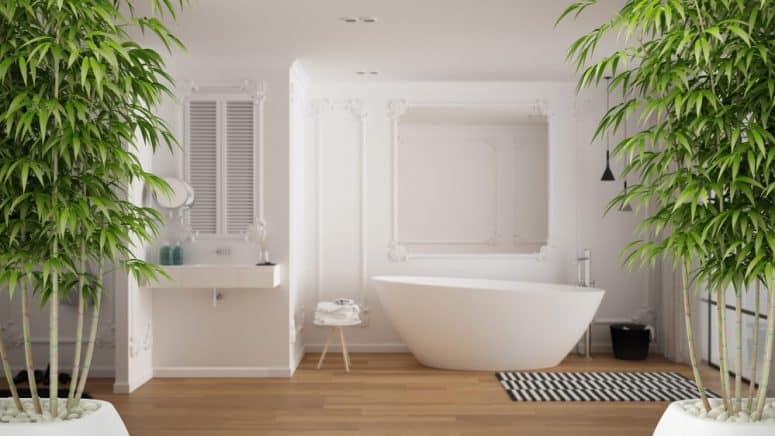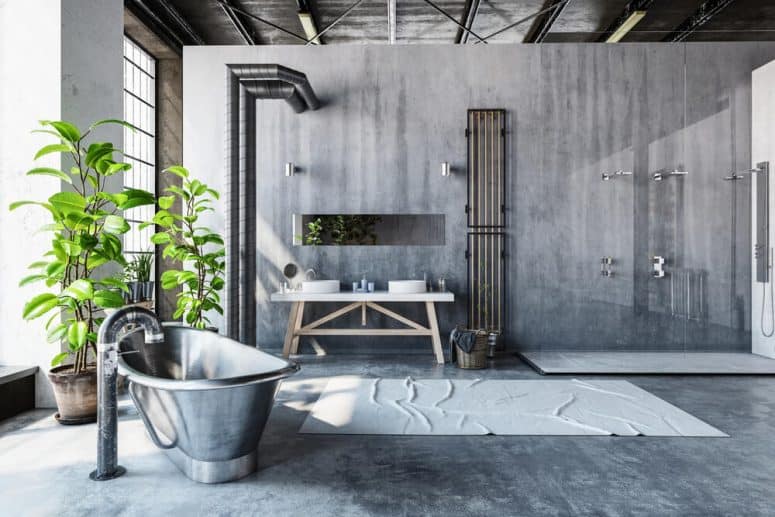Selecting the perfect flooring is an integral part of bathroom decoration. As a space prone to water splashes on both the floor and walls, the bathroom requires careful consideration when choosing the ideal flooring option.
Additionally, the bathroom serves as a place for cleansing and relaxation. Therefore, it is essential to select a flooring material that not only complements the overall decor but also meets the functional requirements of the space.
What to Consider In Choosing Bathroom Flooring
When it comes to bathroom flooring, the primary concern is often water. After all, bathrooms experience constant exposure to water throughout the day. As a result, it is crucial to prioritize waterproof or water-resistant flooring options.
Additionally, the appearance of the flooring should complement the desired style and contribute to a visually pleasing environment in the bathroom. Different bathroom styles may call for specific types of flooring.
Considering the maintenance requirements of the chosen flooring is also essential. Daily water exposure can lead to issues such as color fading or dirt accumulation, so understanding how to properly care for the bathroom flooring is crucial to avoid future difficulties.
Durability is another factor to evaluate when selecting bathroom flooring. By assessing the waterproof feature, maintenance needs, and overall resilience, you can determine if a flooring option meets your desired level of durability.
Budgeting is a practical aspect to consider. It’s important to account for any additional costs such as underlayment or professional installation that may be necessary for the chosen flooring type.
By taking these factors into consideration—appearance, waterproofing, maintenance, durability, and budget—you can make an informed decision and choose the right flooring option for your bathroom.
Best Flooring Options for Bathroom
Based on the considerations mentioned earlier, we have compiled a list of six highly recommended options for bathroom flooring. These choices have been selected for their ability to meet the requirements of appearance, waterproofing, maintenance, durability, and budget:
1. Ceramic/Porcelain Tile

2. Natural Stone

Investing in natural stone for your bathroom is a long-term decision that adds value not only to your bathroom but also to your entire house. Natural stone is renowned for its durability, making it a worthwhile investment.
By installing natural stone in your home, you can potentially increase its resale value. The elegance and timeless appeal of natural stone contribute to a higher market price when selling your house.
There are various types of natural stone available, such as marble, limestone, granite, and more. Each type showcases unique textures and patterns, allowing for versatile design options in both tile and abstract shapes.
The presence of natural stone in your bathroom creates a refreshing and calming atmosphere, perfect for relaxation and rejuvenation.
As a 100% waterproof material, natural stone is suitable not only for bathrooms but also for outdoor applications. However, it requires regular cleaning and sealing to maintain its color and appearance. Rest assured, the cleaning process is simple and easy to perform.
Keep in mind that natural stone tends to have a naturally cool surface. When installed in a bathroom, it may intensify the sensation of coldness. To counter this, you can consider installing radiant heating beneath the stone for added comfort. Alternatively, if you don’t mind the cold feel, there is no cause for concern.
It’s important to note that natural stone can be a relatively expensive flooring option. Therefore, it’s advisable to budget accordingly to accommodate the cost of both the stone itself and its professional installation.
3. Vinyl

When it comes to bathroom flooring, vinyl emerges as an excellent choice. Made from PVC, vinyl flooring replicates the appearance of various materials through printed designs, providing a wide range of options.
Vinyl flooring offers an array of patterns and modern motifs, adding style and coziness to your bathroom. The advancements in Luxury Vinyl Plank (LVP) and Luxury Vinyl Tile (LVT) have contributed to the growing popularity of vinyl flooring due to their versatility.
Available in three forms—plank, tile, and sheet—vinyl flooring is easy to install in a bathroom with slight variations depending on the chosen format. All three forms are 100% waterproof, but vinyl takes the lead with its seamless effect, while plank and tile may still exhibit seams due to grout or side portions. Proper installation can ensure a seamless appearance for your vinyl bathroom flooring.
Installing vinyl plank or tile is relatively straightforward, even for beginners. However, sheet vinyl requires professional assistance for proper installation.
Another advantage of vinyl flooring is its versatility in installation. It can be installed directly over your existing flooring, saving time and effort. However, it’s crucial to ensure that the surface is thoroughly clean, as vinyl flooring can highlight every speck of dirt, which may not feel pleasant underfoot.
Unfortunately, vinyl is not an environmentally friendly material and may pose health concerns to some extent. Additionally, unlike natural stone, vinyl flooring does not contribute to increasing the value of your house in the long run.
4. Engineered Hardwood

While real hardwood flooring is not suitable for bathrooms, there is an alternative known as engineered hardwood flooring. This type of flooring is crafted from natural wood, but it has a plywood base that offers resistance to water and moisture. On the surface, it features a veneered hardwood layer, giving it the appearance of real wood with various color variations.
Installation of engineered hardwood flooring is versatile and relatively straightforward. It can be installed using the floating floor method directly over your existing floor or by creating a new underlayment.
Engineered wood flooring is suitable for bathrooms because it is water-resistant. However, it is important to note that it is not entirely waterproof. While it can withstand water spills, prolonged exposure to flooding may cause damage.
Periodic sanding and sealing can help maintain the durability of engineered wood flooring, allowing you to enjoy the authentic wood feel in your bathroom.
Professional installation is recommended for this type of flooring to ensure precision and avoid potential issues that could compromise its integrity, such as surface leaks that may lead to water seepage and plank damage.
5. Laminate

For an alternative to hardwood flooring, you can consider laminate flooring. It is constructed using natural materials and features a protective wear layer on the surface.
Laminate flooring is known for its easy installation process. While older versions required gluing the planks to the base, newer innovations have introduced click-and-lock and fold-and-lock methods, making installation even simpler.
Once installed, laminate flooring provides a soft and comfortable feel underfoot. Adding an underlayment can enhance the overall comfort level.
One notable advantage of laminate flooring is its generous warranty coverage. Many manufacturers offer warranties ranging from 10 to 30 years, highlighting its durability.
However, similar to engineered wood flooring, laminate flooring is not completely waterproof. This can be a concern when considering it for bathroom use. To mitigate this, ensuring tight seams between the planks and following proper installation techniques can help prevent water seepage.
In the event that water does penetrate the layers of laminate flooring, causing warping and damage, the only solution is to remove and replace the affected sections or the entire floor.
6. Concrete

Which One Is The Best Flooring for Bathroom?
The aforementioned recommendations have highlighted specific flooring types based on their unique features. However, there are alternative options to consider, such as cork and linoleum.
While cork and linoleum can be installed in a bathroom, it is important to note that they may not be as resistant to constant water exposure. Additionally, these types of flooring may require more maintenance compared to others.
Therefore, it is crucial to carefully evaluate your priorities when selecting the best flooring option for your bathroom. Once you have considered the desired specifications and features, it is also important to assess your budget. When your desired specifications align with your budgetary constraints, you can confidently proceed with your chosen flooring option. I’m excited to see the final result!